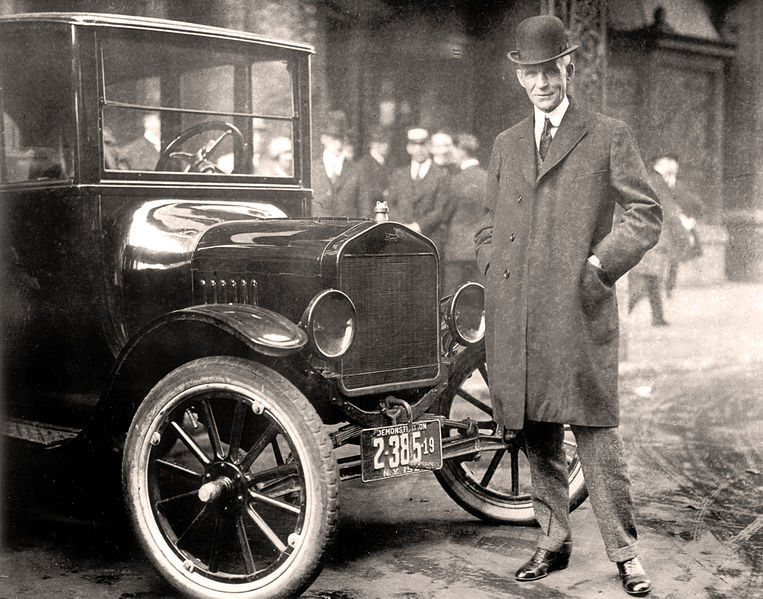Media | Articles
Henry Ford didn’t invent the car, he just made one people would drive
In Henry Ford’s 83 years, the world went from the horse and buggy to the microwave oven, Cold War and Polaroid instant camera. He was alive when Abraham Lincoln was assassinated; and when Bill Clinton and George W. Bush were born. He would have read Huck Finn as an adult (well, he probably wouldn’t have, but that’s another story) and The Jungle Book to his son Edsel (ditto, natch); and could have watched Natalie Wood in a movie. And from the time he was a teenager, Ford was a part of all that change.
As an adolescent, Ford carved out a little machine shop on his family farm in Dearbornville –now Dearborn – Michigan, which would have been completely muscle-powered at the time. By 1878, at the age of 15, he’d built his own steam engine and soon apprenticed in Detroit’s machine shops, working his way up to Chief Engineer at the (Thomas) Edison Illuminating Company of Detroit at the age of 30. Long before then, however, he’d started making cars. More or less.
With his wife Clara feeding in gas, Ford’s first little “Kitchen Sink” engine ran in the family kitchen in late 1893; three years later, he had a larger version of the single powering a bicycle-wheeled Quadricycle. With its founder’s urging, he resigned from Edison in 1899 to start the Detroit Automobile Company (which would eventually become Cadillac); went into bankruptcy 18 months later; started building racecars and won a race with Barney Oldfield driving; and organised the Ford Motor Company in June 1903.
By July 1903, Ford Motor Company was also near bankruptcy, but this time they sold an 8hp Model A for $850, along with taking deposits on two others. Three cars a month was enough to stay afloat and they opened their Piquette Avenue factory in 1904. Two years later, the four-cylinder 15hp Model N was the best-selling car in America. The Model T debuted in 1908.
The drive that moved Henry Ford came at a cost. He did not care to be upstaged by employees and had what many called a dictatorial streak, especially as the 1920s and ‘30s went on, micromanaging every aspect of the company including, at times, his employee’s private lives. He gradually surrounded himself with shady cronies and yes-men, driving away some of the most talented people in Detroit. Some have said that his son Edsel, Ford company president from 1919 until his death in 1943, was bullied to death by his father. Henry was certainly harshly and frequently critical of Edsel in public.
Marketplace
Buy and sell classics with confidence
Ford was also a strange mix of pacifist and fascist. He attempted to hand out peace flyers with every Model T and during World War One, launched (literally) a series of Peace Expeditions to neutral European countries to try to end the war. Much international ridicule ensued, along with multiple obstacles related to sailing around Europe during the Great War. Immediately after, he began a dark persecution of Jewish people and Nazi sympathizing, which included buying a Dearborn newspaper and running a widely-cited crackpot 91-part Jewish conspiracy series; publishing the articles as a four-volume book and distributing it to his dealers (along with his newspaper). According to the New York Times, Ford was among Adolf Hitler’s first foreign backers.
It won him one admirer: In 1938, Ford received the German Third Reich’s Grand Cross of the German Eagle from Hitler, who kept Ford’s picture on his Munich office wall. There is no question that his stature – people were talking about a Henry Ford Presidential run in the Twenties – greatly contributed to the rise of American anti-semitism.
In the early years, Ford’s domineering industrial vision worked – he really was as smart as he thought and with a huge head start, he had the freedom to do things his way. But as competition mounted and the Model T became increasingly outdated, he was slow to adapt and quickly lost ground to General Motors. In fact, when he finally found the need to end Model T production in 1927 – the same year television was invented – production had to switch completely from their Highland Park factory to River Rouge. There were literally no facilities for making anything other than the Model T.
Despite the new Model A, accessible 1932 V-8, Ford’s enduring popularity and success, General Motors took a large share of Ford’s market share, and remained the top seller for many years to come. Ford returned to the company presidency briefly after Edsel’s death, before nominating his grandson Henry II to the position and finally retiring in 1945.
Henry Ford, for all his failings, was remembered and beloved for his successes. In 1946, over 50,000 people attended his 83rd birthday celebration at Ford Field, the year before his death. He was equally reviled as he fought unions mercilessly, but also instituted a generous eight-hour day and $5 daily wage. He broke the Selden Patent on automobiles and established the Ford Foundation, which still gives away over $600 million in grants every year. He was close friends and partners with Edison and spent $1.5 million on electric cars, only to throw it all away when a deal with Edison for Model T batteries fell apart.
Few people since the Founding Fathers have changed the country like Ford; and the very physical landscape of modern America is in large part his doing. As a man, he was as flawed and human as any of us; as a visionary, he was truly a force of nature.
Hagerty’s Essentials is an ongoing series that helps introduce enthusiasts to people, places and things that every well-rounded car lover should know. Rather than being in-depth, Essentials is a quick take giving you a conversational knowledge and ultimately, an idea of how the whole fits together.










